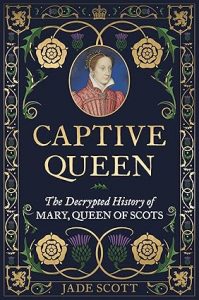‘Captive Queen: The Decrypted History of Mary, Queen of Scots’ by Jade Scott was published in October by Michael O’Mara.
Jade is also the author of ‘The Life and Letters of Lady Anne Percy, Countess of Northumberland (1536–1591).’
Buy ‘Captive Queen: The Decrypted History of Mary, Queen of Scots’:
Follow Jade on Social Media:
Bluesky – Jade Scott@huntingrebels.bsky.social
Twitter/X – DrJadeScott@HuntingRebels
Many thanks to Jade for answering my questions.
Why did you choose this subject for your book?
As a historian of early modern Scotland, it was impossible to not engage with Mary’s reign and captive years in England, but it wasn’t until I did my PhD research on another early modern woman – Lady Anne Percy, Countess of Northumberland – that I really started to think about how Mary has suffered from a very negative or romanticised portrayal over the years. During my PhD I noted how Mary was really a driving force behind a lot of the political schemes that pop up across Europe in the 1570s and 1580s. I was then really fortunate to work with Mary’s letters as a postdoctoral researcher and from then on, I’ve been keen to write a biography of her that really focusses in on the evidence her letters offer. It’s only by situating her letters within early modern cultures of correspondence that we can fully unpack the extent of her agency even as her personal circumstances deteriorated. For me, it felt important that I both challenge the traditional assumptions about Mary – that she was simply a victim and a woman who was content to let people around her direct events – and that I share how amazingly useful letters can be as a source when we understand them as their writers would have.
How important to Mary was the ability to receive and send letters during her captivity in England?
Very quickly after her arrival in England in May 1568, Mary’s access to visitors was curtailed. She did still occasionally have official visits or diplomatic envoys come to her, but the English authorities were reluctant to let her have meetings face-to-face. Letters then became a lifeline for her. They were her main channel of communication for all kinds of subjects, from the personal to the political. We can see how important letters were to her because she regularly complained about being bereft of news and friends at times when her messengers were arrested or her usual routes of sending and receiving letters were restricted. It’s through letters that Mary was able to attempt to improve her personal condition and to maintain supporters across Scotland, England and beyond.
Do you have a favourite letter?
It’s hard to pick a favourite because we are so lucky with Mary to have such a huge number of letters survive. There are thousands of her letters in archives and private collections across the world. With Mary we have letters of all sorts, playful and friendly notes, serious letters of political importance, and angry and frustrated missives. If I had to pick, I’d probably pick one she sent to her sister-in-law Annas Keith, Countess of Moray and Argyll after the assassination of Annas’ husband and Mary’s half-brother, James Stewart, Earl of Moray in January 1570. The Earl of Moray had become Regent of Scotland after Mary was forced to abdicate in 1567 and though she had been very close to Annas prior to this, things naturally took a turn for the worse! Mary was determined to have some jewels returned to her from Annas, but Annas was equally unwilling to give them up. In this letter, Mary had her secretary write up a formal letter of request for the jewels and though it is cool in tone it is not especially insulting. But she also added in a postscript in her own hand threatening Annas and her children ‘with her displeasure’ if she disobeys her. It’s a fantastic example that really gives you a sense of the real-life human interactions behind these big moments in her captive life. And I love it because it shows that Mary wasn’t this idealised, cardboard cut-out woman.
What do Mary’s letters add to our understanding of events?
Mary’s letters are essential sources of information for both her everyday life and the political circumstances of her captive years. Her letters show that she was not only aware of plots and schemes being organised for her release but that she was actively directing many of these. They also show that she pursued multiple different avenues to secure her liberty, ranging from beneficial marriage negotiations to military interventions. The events of the final plot to free Mary, known as the Babington Plot of 1585-86 after one the gentlemen plotters involved, come to greater light thanks to her letters. We’ve long known that it was an intercepted, and indeed altered, letter between Mary and Babington that led to her final trial for treason against Elizabeth I of England, but lots of other letters she wrote were used as evidence against her too. Letters between Mary and the Spanish Ambassador, Bernardino de Mendoza and between her and her own ambassador in France, James Beaton, Archbishop of Glasgow, many of them written in code, offer crucial evidence of her knowledge of and encouragement of the plot – though crucially not of any intent to kill Elizabeth, as she was charged with at her trial.
Do her letters add to our understanding of Mary as a person?
I think that her letters show that Mary was a very skilful political strategist. It’s very easy to retrospectively look back, when we know the ending, and say well she didn’t go a very good job, but actually if we look at her letters we can see that she was a woman with remarkable agency even as she was held a captive for so long. She directed attempts to secure her freedom and when this became increasingly unlikely she then used her letters to ensure her own memorialisation as a victim of English, anti-Catholic agendas. By unravelling the complexities of her letters and embedding them in contemporary cultures of letter-writing, we get a more nuanced – and less gendered – understanding of her.



































